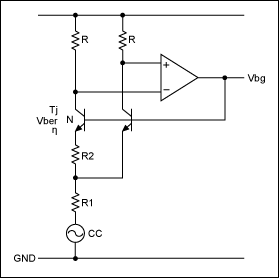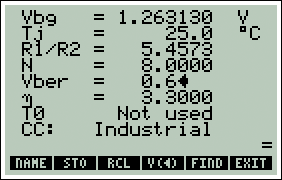Bandgap Reference Calculator Tutorial
Abstract
The Bandgap Reference Calculator (BGRC) aids in the design and analysis of a Brokaw bandgap reference circuit. It calculates all circuit parameters and the output voltage as a function of junction temperature. The calculator can be used with an HP® 50g calculator or a free PC emulator.
Introduction
Steve Edwards, an experienced analog design engineer, has written several calculators to automate repetitive tasks. These tools are being shared to help other analog design engineers who select, specify, and characterize analog circuits. We will summarize the functionality of one such tool, the Bandgap Reference Calculator.
Bandgap Reference Calculator
The Bandgap Reference Calculator (BGRC) is a program for the HP 50g calculator that aids in the design and analysis of a two-transistor Brokaw bandgap voltage reference circuit. BGRC calculates all circuit parameters and the output voltage as a function of junction temperature. BGRC can also run on a PC using the free program HPUserEdit 5.4, found at www.hpcalc.org or at Steve's Analog Design Calculators page.

Figure 1. Brokaw bandgap reference cell.
The BGRC is an excellent teaching tool; it allows one to design theoretically perfect bandgap circuits. The subjects explored include first-order trimming to minimize the slope of the error with temperature, and the optimization of the second-order curvature correction circuit. It also includes warnings to avoid the pitfalls of the industry-standard box method for specifying drift or "temperature coefficient."
The BGRC can find any circuit parameter as a function of the others, making it useful for both design and analysis of bandgap reference circuit. Eight parameters can be entered or found:
- Output bandgap voltage, Vbg, in volts
- Junction temperature, Tj, in °C
- Resistor ratio, R1/R2
- Transistors emitter-area ratio, N
- Base-emitter voltage at 25°C, Vber, in volts
- Process-dependent parameter, η
- Magic temperature, T0, in °C
- Curvature-correction select, CC

Figure 2. The Bandgap Reference Calculator initial screen display.
The user's guide (available as part of the BGRC program package) provides instructions for the calculator's use, theory and equations, and most importantly, a practical example of its use in circuit design and analysis. The practical example will use the BGRC to design a bandgap reference (Brokaw cell) with its temperature drift (TCO) optimized in three ways:
- With the lowest drift at or near room temperature without curvature correction
- With the lowest average drift over the commercial temperature range without curvature correction
- With the lowest possible drift over the commercial temperature range using curvature correction